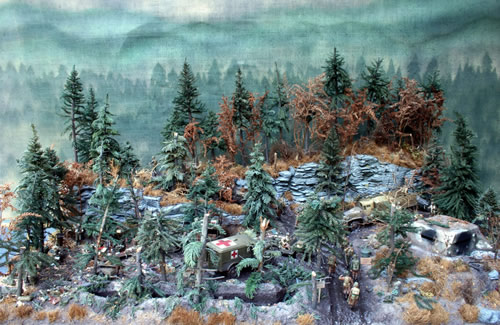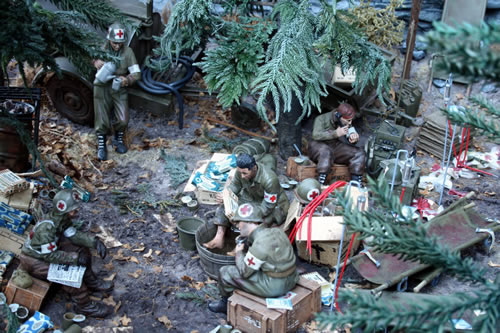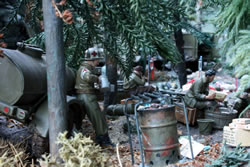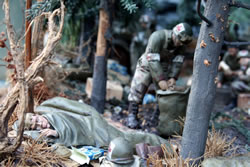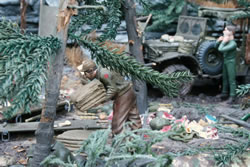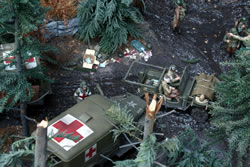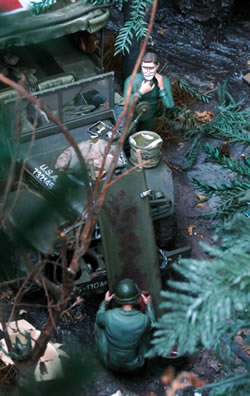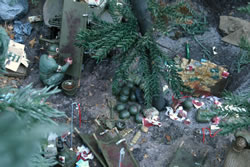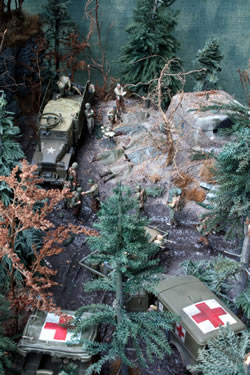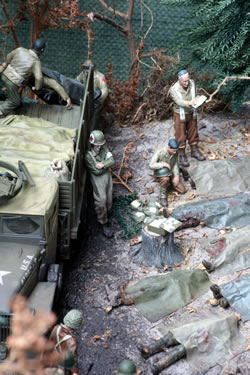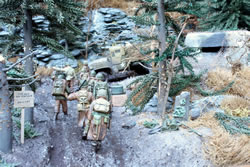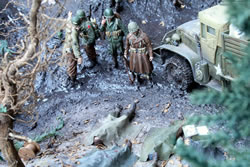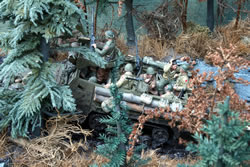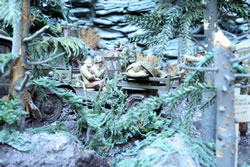|
"Between
Life and Death in the Hürtgen Forest" |
 |
|
Nearly lost amid the towering pines of the Hürtgen Forest, a slender thread of rutted road, muddy from the cold October rains, rises between a slight, battle-scarred clearing and a burned out concrete pillbox. Confronted by a wall of dark gray shale, the road abruptly turns left and climbs another rock formation before if disappears from sight at the top of the hill. This cold, thick, forbidding terrain favors the defender, and challenges the resolve of the attackers, even the most experienced among them. To the left side of the road, a battalion aid station of the 28th Infantry Division's 110 Regiment is wedged amidst the trees and rain-filled trenches of the recently (and perhaps temporarily) overcome German defenses. A dozen medics and litter-bearers take advantage of a brief lull in the desperate fighting. One soaks his feet in a wooden tub while opening a box of K-rations, talking to two others sitting on supply crates. One's already fast asleep in his bag, an opened can of rations and spoon nearby. A corpsman goes through his duffle bag, perhaps looking for dry socks. One fellow is carrying fresh blankets from the WC 54 Dodge ambulance. The driver sits in the cab, talking to a medic through the open door. Another fellow is back by the 1/4-ton trailer and water trailer, pouring himself a cup of coffee. The captain is on the radio with HQ, checking his watch to verify the time when this brief quiet will end, and the wounded from the next assault will begin arriving..
The
ground is covered with bloody bandages and empty medical cartons. Plasma bottles,
with their red rubber tubing, hang from metal stanchions. Piles of clothing, boots
and helmets hurriedly stripped from the wounded fill watery shell craters. Empty
K ration boxes and tin cans mix with leaves and pine boughs to accent the cold,
soggy landscape. On the other side of the road, atop a slight rise, the pillbox sits like a pockmarked skull with nothing but blackness behind its vision slits. On the slope between the slate wall and the pillbox, tarps cover six bodies. The seventh is making his way to a GMC 2.5 ton truck, carried on a stretcher by two black enlisted men from the quartermaster's segregated graves registration team. There's not much room on the truck. A heavy canvas tarp covers the bodies that rise to the tops of the braced walls. Clearly, this will be the last pick-up on this run.
One
of the division's busy chaplains stands at the feet of the dead, offering last
rites. The registration team's officer kneels amid the personal effects bags for
each man. The name of each man has been dutifully logged from the dogtags arrayed
on the lid of the file box. It's the beginning of a long, sad trail of paper leading
from this green hell to the trembling hands at home that open the telegrams that
always begin the same, "We regret to inform you...." A
medic, who has officially transferred the dead to their new keepers, leans against
the truck, oblivious to the intonations of the chaplain. He's heard it too far
often and could recite it in his sleep. If he could get any. But now he's distracted
by a commotion on the oozing brown road, a rueful grimace on his face.
As
a long line of foot soldiers follow the troop-laden M3A1 halftrack churning up
the slope to the top of the formation, a knot of men have paused at the base of
the slope. Some look up at the tarp-covered mounds. They knew these men. They
fought beside them. They heard their cries, saw them fall. Now they have to go
back up there and try to finish this ugly business. "What is the point?"
one of them shouts at his sergeant, who resolutely points him to the top of the
hill.
The other men move along, making way for the ambulance jeep leaving the aid station to ferry the last two breathing casualties down to the field hospital. The jeep's wheels sink deep into the relentless muddy road that carries men between life and death in the Hürtgen Forest. "Between
Life and Death..."
|
 |
 |
 |
 |
 |
 |
 |
 |
 |
 |
 |
 |
|
